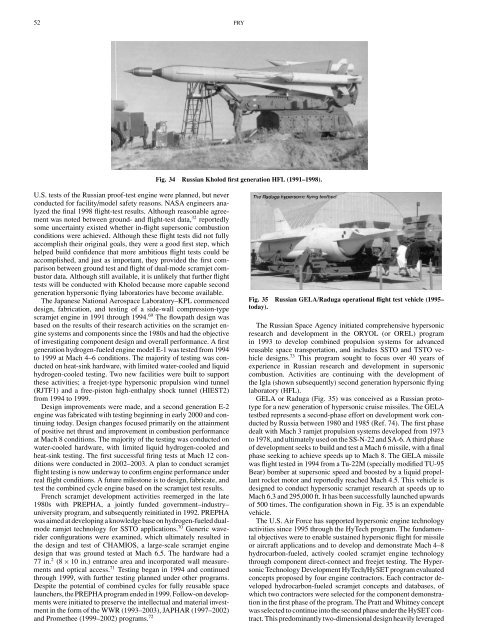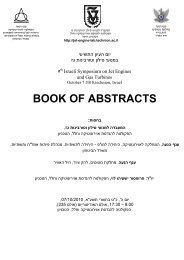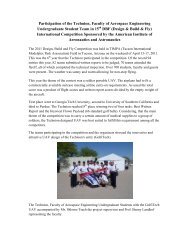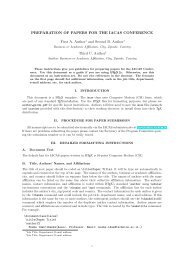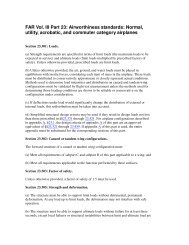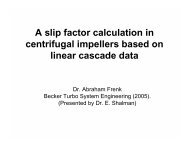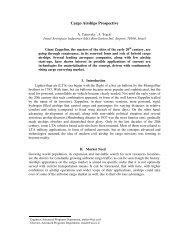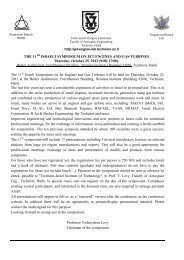A Century of Ramjet Propulsion Technology Evolution - Faculty of ...
A Century of Ramjet Propulsion Technology Evolution - Faculty of ...
A Century of Ramjet Propulsion Technology Evolution - Faculty of ...
Create successful ePaper yourself
Turn your PDF publications into a flip-book with our unique Google optimized e-Paper software.
52 FRY<br />
U.S. tests <strong>of</strong> the Russian pro<strong>of</strong>-test engine were planned, but never<br />
conducted for facility/model safety reasons. NASA engineers analyzed<br />
the final 1998 flight-test results. Although reasonable agreement<br />
was noted between ground- and flight-test data, 32 reportedly<br />
some uncertainty existed whether in-flight supersonic combustion<br />
conditions were achieved. Although these flight tests did not fully<br />
accomplish their original goals, they were a good first step, which<br />
helped build confidence that more ambitious flight tests could be<br />
accomplished, and just as important, they provided the first comparison<br />
between ground test and flight <strong>of</strong> dual-mode scramjet combustor<br />
data. Although still available, it is unlikely that further flight<br />
tests will be conducted with Kholod because more capable second<br />
generation hypersonic flying laboratories have become available.<br />
The Japanese National Aerospace Laboratory–KPL commenced<br />
design, fabrication, and testing <strong>of</strong> a side-wall compression-type<br />
scramjet engine in 1991 through 1994. 69 The flowpath design was<br />
based on the results <strong>of</strong> their research activities on the scramjet engine<br />
systems and components since the 1980s and had the objective<br />
<strong>of</strong> investigating component design and overall performance. A first<br />
generation hydrogen-fueled engine model E-1 was tested from 1994<br />
to 1999 at Mach 4–6 conditions. The majority <strong>of</strong> testing was conducted<br />
on heat-sink hardware, with limited water-cooled and liquid<br />
hydrogen-cooled testing. Two new facilities were built to support<br />
these activities; a freejet-type hypersonic propulsion wind tunnel<br />
(RJTF1) and a free-piston high-enthalpy shock tunnel (HIEST2)<br />
from 1994 to 1999.<br />
Design improvements were made, and a second generation E-2<br />
engine was fabricated with testing beginning in early 2000 and continuing<br />
today. Design changes focused primarily on the attainment<br />
<strong>of</strong> positive net thrust and improvement in combustion performance<br />
at Mach 8 conditions. The majority <strong>of</strong> the testing was conducted on<br />
water-cooled hardware, with limited liquid hydrogen-cooled and<br />
heat-sink testing. The first successful firing tests at Mach 12 conditions<br />
were conducted in 2002–2003. A plan to conduct scramjet<br />
flight testing is now underway to confirm engine performance under<br />
real flight conditions. A future milestone is to design, fabricate, and<br />
test the combined cycle engine based on the scramjet test results.<br />
French scramjet development activities reemerged in the late<br />
1980s with PREPHA, a jointly funded government–industry–<br />
university program, and subsequently reinitiated in 1992. PREPHA<br />
was aimed at developing a knowledge base on hydrogen-fueled dualmode<br />
ramjet technology for SSTO applications. 70 Generic waverider<br />
configurations were examined, which ultimately resulted in<br />
the design and test <strong>of</strong> CHAMIOS, a large-scale scramjet engine<br />
design that was ground tested at Mach 6.5. The hardware had a<br />
77 in. 2 (8 × 10 in.) entrance area and incorporated wall measurements<br />
and optical access. 71 Testing began in 1994 and continued<br />
through 1999, with further testing planned under other programs.<br />
Despite the potential <strong>of</strong> combined cycles for fully reusable space<br />
launchers, the PREPHA program ended in 1999. Follow-on developments<br />
were initiated to preserve the intellectual and material investment<br />
in the form <strong>of</strong> the WWR (1993–2003), JAPHAR (1997–2002)<br />
and Promethee (1999–2002) programs. 72<br />
Fig. 34 Russian Kholod first generation HFL (1991–1998).<br />
Fig. 35 Russian GELA/Raduga operational flight test vehicle (1995–<br />
today).<br />
The Russian Space Agency initiated comprehensive hypersonic<br />
research and development in the ORYOL (or OREL) program<br />
in 1993 to develop combined propulsion systems for advanced<br />
reusable space transportation, and includes SSTO and TSTO vehicle<br />
designs. 73 This program sought to focus over 40 years <strong>of</strong><br />
experience in Russian research and development in supersonic<br />
combustion. Activities are continuing with the development <strong>of</strong><br />
the Igla (shown subsequently) second generation hypersonic flying<br />
laboratory (HFL).<br />
GELA or Raduga (Fig. 35) was conceived as a Russian prototype<br />
for a new generation <strong>of</strong> hypersonic cruise missiles. The GELA<br />
testbed represents a second-phase effort on development work conducted<br />
by Russia between 1980 and 1985 (Ref. 74). The first phase<br />
dealt with Mach 3 ramjet propulsion systems developed from 1973<br />
to 1978, and ultimately used on the SS-N-22 and SA-6. A third phase<br />
<strong>of</strong> development seeks to build and test a Mach 6 missile, with a final<br />
phase seeking to achieve speeds up to Mach 8. The GELA missile<br />
was flight tested in 1994 from a Tu-22M (specially modified TU-95<br />
Bear) bomber at supersonic speed and boosted by a liquid propellant<br />
rocket motor and reportedly reached Mach 4.5. This vehicle is<br />
designed to conduct hypersonic scramjet research at speeds up to<br />
Mach 6.3 and 295,000 ft. It has been successfully launched upwards<br />
<strong>of</strong> 500 times. The configuration shown in Fig. 35 is an expendable<br />
vehicle.<br />
The U.S. Air Force has supported hypersonic engine technology<br />
activities since 1995 through the HyTech program. The fundamental<br />
objectives were to enable sustained hypersonic flight for missile<br />
or aircraft applications and to develop and demonstrate Mach 4–8<br />
hydrocarbon-fueled, actively cooled scramjet engine technology<br />
through component direct-connect and freejet testing. The Hypersonic<br />
<strong>Technology</strong> Development HyTech/HySET program evaluated<br />
concepts proposed by four engine contractors. Each contractor developed<br />
hydrocarbon-fueled scramjet concepts and databases, <strong>of</strong><br />
which two contractors were selected for the component demonstration<br />
in the first phase <strong>of</strong> the program. The Pratt and Whitney concept<br />
was selected to continue into the second phase under the HySET contract.<br />
This predominantly two-dimensional design heavily leveraged


